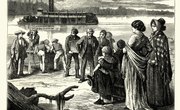In the late 1800s, the United States government's policy towards Native Americans -- most of whom had been removed to reservations, primarily in the West -- was focused on assimilating them into European-American culture. The solution to "the Indian problem," authorities and reformers believed, lay in reducing their authority, educating their youth and relieving them of their massive landholdings. The effects of these policies on the Native American population were generally negative. Native American culture was suppressed and the population experienced greater economic hardships. Conflicts with European-American settlers and government authority continued.
No Sovereignty, No Identity
The Indian Appropriations Act of 1871 ended the government's policy of making treaties with Native American tribes as treaty-making was reserved for dealings with sovereign nations. The United States did not recognize Native American tribes as sovereign nor did it recognize Native American leaders as heads of state. Instead, the U.S. government regarded all Native Americans simply as individuals and wards of the government. The act left Native Americans in limbo: they were not sovereigns when the government found it inconvenient to treat them as such, but also were not citizens.
Education as Erasure
In the late 19th century, the U.S. government and several reform organizations gave increased priority to educating Native American children in European culture and Christianity. Reservation schools proved least effective as children were still heavily influenced by family cultural traditions. Local boarding schools also failed to break children's ties to Native American beliefs and customs as families simply moved closer to the schools. Distant boarding schools, such as the Carlisle Indian Industrial School in Pennsylvania, took students far from their Western homes, including the Rosebud Reservation in South Dakota. Though these schools were most effective in disassociating students from their cultures, most students eventually returned to their reservations.
Crime and Punishment
Until the late 1800s, Native Americans rendered justice within their own society through tribal councils. In 1885, Congress enacted the Major Crimes Act. This act gave the federal government the authority to try serious crimes committed by Native Americans, even if the crime only involved Native Americans and occurred on Native American land. Initially, the act gave the federal government authority to prosecute seven major crimes but it was eventually expanded to include 15 crimes. Tribal councils, however, retained the right to resolve other, less serious criminal issues.
Taking Apart a Nation
The General Allotment Act of 1887, also known as the Dawes Act, dealt a devastating blow to Native Americans. Under the act – which was designed to force individual land ownership on Native Americans – families were allotted between 40 and 160 acres of land. All land not allotted was sold to non-native settlers as surplus land. The act destroyed tribal tradition of communal land ownership. Many Native Americans were cheated out of their allotments or were forced to sell them. Ultimately, Native Americans lost millions of acres of Western native lands. Poverty among Native Americans became widespread.
A Festering Wound
In 1890, a spiritual movement known as Ghost Dance was spreading through South Dakota's Pine Ridge reservation. Members believed practicing the Ghost Dance would restore Native Americans to prominence and destroy the European settlers. On December 15, 1890, the Lakota Sioux chief Sitting Bull was killed while being arrested on suspicion of being a Ghost Dancer. Two weeks later, the U.S. Cavalry surrounded a band of Ghost Dancers near Wounded Knee Creek. A violent conflict ensued and at least 150 Native Americans, including women and children, were slaughtered. It was the last major conflict between the Army and Native Americans in the 1800s. Nearly a century later, however, the long-simmering resentments of Native Americans erupted in violence, again at Wounded Knee.
Related Articles
Resources
Writer Bio
Laura Leddy Turner began her writing career in 1976. She has worked in the newspaper industry as an illustrator, columnist, staff writer and copy editor, including with Gannett and the Asbury Park Press. Turner holds a B.A. in literature and English from Ramapo College of New Jersey, with postgraduate coursework in business law.











